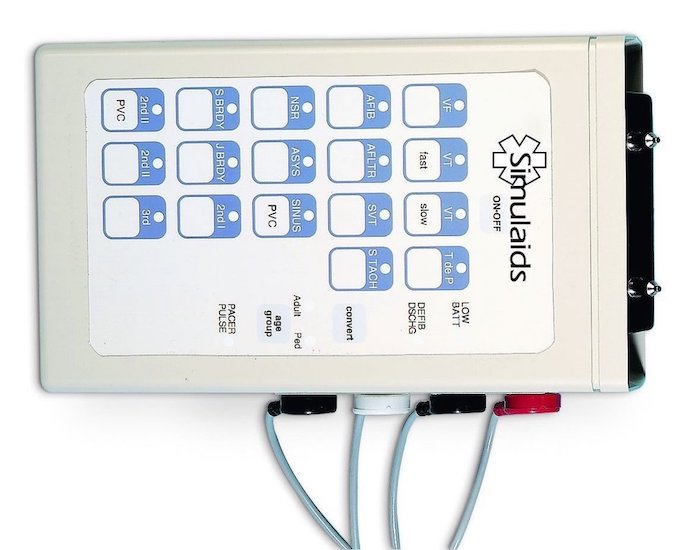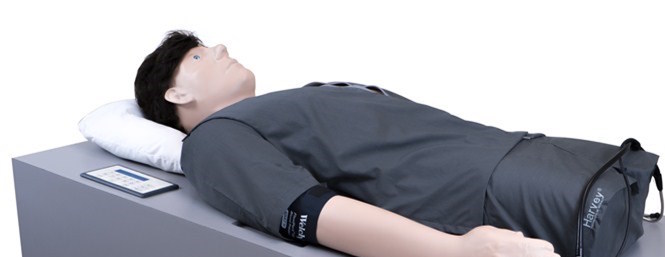Cardiac Simulator
A Cardiac Simulator is an electrocardiogram (ECG) simulation tool that works to simulate an ECG for cardiac rhythms. Typically offered in the form of a software program or website, a Cardiac Simulator can be used by learners to begin to trace ECGs and subsequently record the electric pulse of the heart. Mimicking patient vital signs, this simulation tool can also be used to train on how to check for a variety of different heart conditions and problems. Usually these devices can be used with a manikin or other medical simulator to practice operating defibrillators or pacers through adapters enabling for real time ECG rhythms during clinical simulation exercises.
Just like in the case of a physical ECG machine, a Cardiac Simulator is able to detect the orderly progression of beats a heart is producing. Traced and recognized by the machine, the simulator will also show whether or not the beats produced can be considered “normal.” If not, the simulator will offer learners enough information for the to gather a general sense of the type of issue or condition presented.
In addition to being used by learners and educators in cardiology, Cardiac Simulators are also great tools for emergency medical technicians (EMTs) looking to sharpen their skills. Learning to recognize common cardiac readings quickly and accurately will help a learner to become much more adept throughout their career. Being able to correctly interpret the ECG readings is vital to a successful treatment plan for the patient.
Sponsored Content:
Other features that Cardiac Simulator users seek as well include the ability to assess proarrhythmic potential by accounting for the inhibition of cardiac ion channels. Being able to evaluate the impact of physiological, genetic factors and demographic on drug-triggered cardiotoxicity is another popular lesson. Lastly the potential to assess drug-related influence on ventricular ion current and simulated ECGs is important for learners to identify ways to account for participants who may be receiving treatment for more than one condition.
The clear benefit of utilizing Cardiac Simulators is that they are essentially new flexible, Excel-based tools that enhance visualization and analysis of simulation results. Being an all-in-one tool, users can learn how to identify potential safety issues sooner. The enhanced QSAR models also enable assessment of drug triggered ion channel current inhibition even when in vitro data are not available.
These models are made possible due to the complete learning software and CSS which is designed to be intuitive and easy for non-modelers to use. To maximize a learner’s investment in the software, cascading style sheets (CSS) are connected to the Simcyp Simulator allowing use of the leading platform for population-based IVIVE/PBPK.
Click Here to Connect to Leading Simulated Cardiology Vendors
Sponsored Content:
Overall, these simulators can be used on a number of computers which meet specifications and that enable sound. Although, Cardiac Simulators come in many models and styles, the learning opportunity remains largely advantageous to those hoping to identify cardiac rhythms in the field.
Cardiac Simulator Examples
There are many different kinds of Cardiac Simulators. While some are compact and portable, others will include a full manikin. The type of Cardiac Simulator one should purchase should depend on learning needs, storage capabilities and price restrictions. Here are some examples of Cardiac Simulators currently on the market:
Another new tool for Cardiac Simulation is from Epicardio. The Epicardio Heart Simulator App represents a revolution in digital Cardiac Simulation by combining 3d graphics, realistic animation, ECG visualizations, educational tools, and ease of use. By creating a realistic visual presentation of the heart with everything from afib to Supraventricular Tachycardias, learners will be better understand to experience ECG simulation in real time. Embedded throughout the application is an ECG Simulator enabling for learners to experience rhythms in 3d animated fashion, from guiding lead placements to watching electrical pulses as they happen. This advanced real-time 3D medical simulator shortens the cardiology learning curve by quickly showing true-to-life patient responses on your desktop computer, iOS phone and over the web.
Those looking for cardiopulmonary ausculation cardiac simulators should learn more about the Harvey Manikin from the University of Miami and the Student Auscultation Manikin from Cardionics, or the The Cardiology Patient Simulator K from Kyoto Kagaku.
Netech Biomedical & Industrial Test Instruments, headquartered in Farmingdale, NY, is one company creating Cardiac Simulators. Allowing learners to accurately test and verify the performance of patient monitoring equipment systems, the company offers different patient simulator models with their own unique set of features. These products include an ECG Simulator, Cardiac Rhythm Generator, Blood Pressure Simulator and Output Simulator.
The MiniSim 1000 Arrhythmia Simulator offers a powerful yet basic Cardiac Rhythm Generation simulator in a compact case. This product is designed for testing the performance of all ECG monitoring instrumentation both quickly and easily. Other features of the MiniSim 1000 are that the simulator is a comprehensive microprocessor based instrument is menu-driven using the tactile feel keypad and easy-to-follow LCD display.
Next, the MiniSim 1000 patient Simulator is a multi-parameter Cardiac Patient Simulator designed to test and verify the performance of patient monitoring systems with speed and ease. This microprocessor-based instrument is also menu-driven by the soft touch keypad and intuitive LCD display. The MiniSum 1000 simulates ECG, arrhythmia, blood pressure, respiratory simulation and temperature, as well as performance waveform including sine, triangular, pulse and square wave.
The MiniSim EEG Simulator is then designed to test EEG instruments including recorders and sleep study monitors. This microcontroller-based instrument has five separate floating outputs and simulates Alpha-Beta Rhythm ABR, Sine, Square and Triangle waveforms with user selectable frequencies and amplitudes from 10 microvolt to 3.5 milli volt.
The KindHeart Thoracic Surgery Simulator (TSS): The KindHeart Thoracic Surgery Simulator (TSS) model consists of a porcine heart and left lung that can realistically beat and bleed. This model requires a silicone manikin and pump system. There are three variations of the thoracic model:
- Standard: The standard model. Possible simulated tasks include lymph node dissection, fissure dissection, vessel dissection, left upper lobectomy, and stapler demonstration.
- Completed Fissure: This model has a pre-completed fissure. Possible simulated tasks include vessel dissection, left upper lobectomy, and stapler demonstration).
- Fully Dissected: This model has a fully completed fissure with pulmonary artery dissection. Possible simulated tasks include stapler demonstration and vessel ligation.
- Thymectomy: The heart in this model is fully encased in pericardium. Can be used to simulate a thymectomy.
Lastly, the MicroSim COS Cardiac Output Simulator is the only cardiac output simulator in true waveform. This product is ideal for testing the performance of Thermal Dilution Cardiac Output Monitoring systems. The MicroSim COS Cardiac Output Simulator simulates Baxter Edwards catheter compatible. This tool also simulates four blood flow rates, two blood temperatures and two injectate temperatures may be selected.
Also introducing Cardiac Simulation technology, Fluke Biomedical, headquartered in Cleveland, OH, has founded the PS410 Cardiac and Arrythmia Simulator. This product is another high-performance arrhythmia Cardiac Simulator device for patient monitor testing. The handheld device simulates a full range of cardiac rhythms along with a wide variety of electrocardiogram conditions. ThePS410 Cardiac and Arrythmia Simulator additionally includes pacemaker simulation, 35 arrhythmia selections and adult and pediatric normal-sinus rhythms.
Easy to transport and store, the PS410 is a compact and small enough to fit in a pocket. The PS410 product was designed to weigh less than a pound and is easy to operate. To utilize, technicians and learners need to connect the PS410 to the device under test and use the PS410 keypad to enter the code presets. The PS410 then transmits the selected preset simulations to the device under test.
Other companies producing Cardiac Simulators include ones from Simulaids, SkillStat Learning Inc., Dart Sim Inc., Pronk Technologies Inc. and Nasco Life. Additionally, there are some Cardiac Simulators available online that can provide modules on a limited number of common ECG readings for heart problems. These conditions normally include heart murmurs, sinus arrhythmia and hypertension. Generally, a medical-grade Cardiac Simulator will offer many more in-depth conditions and options for a learner to study.
Cardiac Simulation Latest News
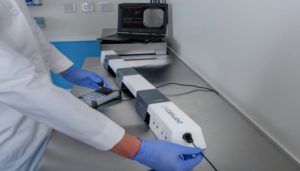
CAE Healthcare Releases Enhanced CathLabVR Cardiac Training Tool

15 Must Know Healthcare Simulation Terms For 2020
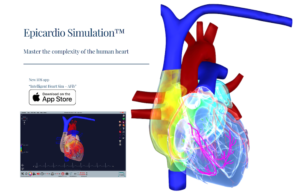
Epicardio Heart Simulator App Changes Cardiac Education Forever

A Closer Look at Harvey: The Leading Cardiopulmonary Patient Simulator From the Gordon Center
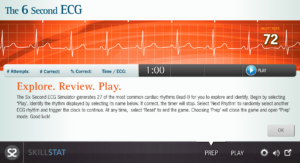
Free ECG Simulator Game

University of Glamorgan Shares Online ECG Simulator
Sponsored Content:



